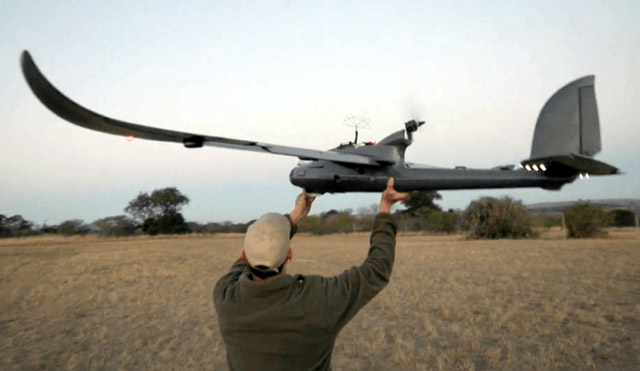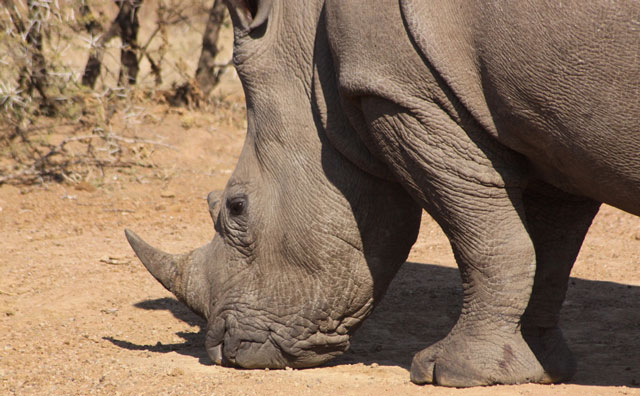
In 2014, 1 215 rhinos were killed in South Africa for their horns, which end up in Asia as supposed cures for a variety of ailments. An estimated 30 000 African elephants were slaughtered last year for their tusks to be turned into trinkets. The world loses three rhinos a day and an elephant every 15 minutes. Simply stated, this is an unsustainable situation.
Our team at the University of Maryland’s Institute for Advanced Computer Studies has created a new multifaceted approach to combat poaching in Africa and Asia. We devise analytical models of how animals, poachers and rangers simultaneously move through space and time by combining high-resolution satellite imagery with loads of big data — everything from moon phases, to weather, to previous poaching locations, to information from rhinos’ satellite ankle trackers — and then applying our own algorithms. We can predict where the key players are likely to be, so we can get smart about where to deploy rangers to best protect animals and thwart poachers.
The real game changer is our use of unmanned aerial vehicles (UAVs) or drones, which we have been flying in Africa since May 2013. We’ve found that drones, combined with other more established technology tools, can greatly reduce poaching — but only in those areas where rangers on the ground are at the ready to use our data.
In the past 10 years, the poaching of elephants and rhinos has increased exponentially, primarily because it’s a very lucrative criminal business. Rhino horns can fetch more than US$500 000 or over $50 000/kg — this is more than the cost of any illegal narcotic — and a pair of elephant tusks can reach $125 000. Most of these illegal activities are run by Asian criminal syndicates and there are well-founded beliefs that some of these proceeds are being funnelled to political extremists in Africa.
Technology is a marvellous tool but it must be the right solution for a particular problem. Engineering solutions that might work with the US military looking for people planting IEDs in Afghanistan will not necessarily work in the African bush, at night, searching for poachers. The most challenging question about how UAVs are used in Africa is when and where to fly them.
Africa is too big to be simply launching small drones into the night sky with the hope of spotting rhinos or poachers by chance. This is where the analytical models come into play. Based on our models, we know, with near 90% certainty, where rhinos are likely to be on a particular night between 6.30pm and 8pm, prime time for killings. At the same time, by mathematically recreating the environment when previous poachings have occurred, we have a very good idea of when and where poachers are likely to strike.
We don’t have to find poachers, we just need to know where the rhinos are likely to be.
For example, a large proportion of poachings occur on the days around a full moon; it makes sense since that’s when poachers can easily see their prey. In one area where we have months of experience, we discovered that nearly every poaching occurred with 160m of a road. It’s simple. The poachers are driving the perimeter of the park in the late afternoon spotting animals near the park fence; they return just after sundown, kill the animal and drive away. We pile on the data, and the algorithms do the rest.
Data informs rangers
The key is that the satellites, the analytics and maths, and the UAVs are integrated into a solutions package. We crunch the data, and the model tells us precisely where we should deploy our rangers, on any specific night, so they will be in front of the rhinos and can intercept the poachers before they reach the target animal. After all, there’s no value in rangers patrolling parts of the park that these animals are unlikely to ever visit. The Kruger National Park is huge. Like a bank robber who robs banks because that’s where the money is, we want our rangers to be near the rhinos because that’s where the poaching is.
On our first UAV flight in South Africa, the drone flew to our pre-determined spot and immediately found a female rhino and her calf; they were within 30m of a major road. We decided to circle the drone over the rhinos and within minutes a vehicle stopped at the park’s fence. Three individuals exited the car and began to climb the fence to kill the rhinos. Our rangers had been pre-deployed to the area and arrested the three poachers in under three minutes. This episode has been repeated dozens of times over the past 20 months.

The most critical issue is not how far or how long a UAV can fly but how fast can a ranger be moved, in the bush at night, to successfully intercept poachers. The UAVs are simply our eyes in the night sky. Watching their live infrared video streams, we move our rangers as if they were chess pieces. Even with great maths, we have some variance and that means we might be 200m off a perfect positioning. The UAVs can see poachers at least 2km from the rhinos. So we have 45 minutes to move our people into the most optimal position — based on our real world trials on how quickly they can move through the bush at night.
We’ve had hundreds of night flights with over 3 000 flight hours in the past 20 months and here is what we’ve learned. First, on the first few days after we begin operating in a new area, we arrest a number of poachers and they’re being prosecuted to the fullest extent of local laws.
Second, our models are heuristic in that they are constantly learning and self-correcting, on the lookout for changes in the patterns they’ve identified. This is critical since poachers will try to change their behaviour once they learn that they are at an extremely high risk of apprehension. The sheer number of animals being killed shows us that, up until the UAVs take to the air, most poachers have been able to operate with impunity.
The most important finding is that in every area where we have put our solutions package to work and the UAVs are flying, poaching stops within five to seven days. Period — it stops. The bad news is that the poachers are moving to regions where we are not operating. To really address the challenges of poaching in the region, all the nations in Southern Africa should be willing at least to test our system in their most critically endangered areas.![]()
- Thomas Snitch is visiting professor in advanced computer studies at the University of Maryland
- This article was originally published on The Conversation

